University Case Study: MGT8033 Leadership and Employee Relations
VerifiedAdded on 2023/01/23
|11
|3325
|58
Case Study
AI Summary
This case study analyzes leadership and management challenges within the context of Ridgeway, focusing on the relationship between Susan Wong and her staff. It identifies issues such as lack of coordination, employee involvement, motivation, and proper planning. The report explores the impact of Susan's leadership style, particularly her traditional approach and its effects on employee relations and interpersonal emotion management. It examines the applicability of authentic leadership theory and proposes strategies for Susan to improve the situation, including understanding employees, situation modification, cognitive change, attentional deployment, and modulating emotional responses. The case study highlights the importance of effective communication, emotional intelligence, and teamwork for organizational success. The solution provided delves into the issues within the company and suggests strategies to improve the leadership and employee relations to enhance the performance of the business.
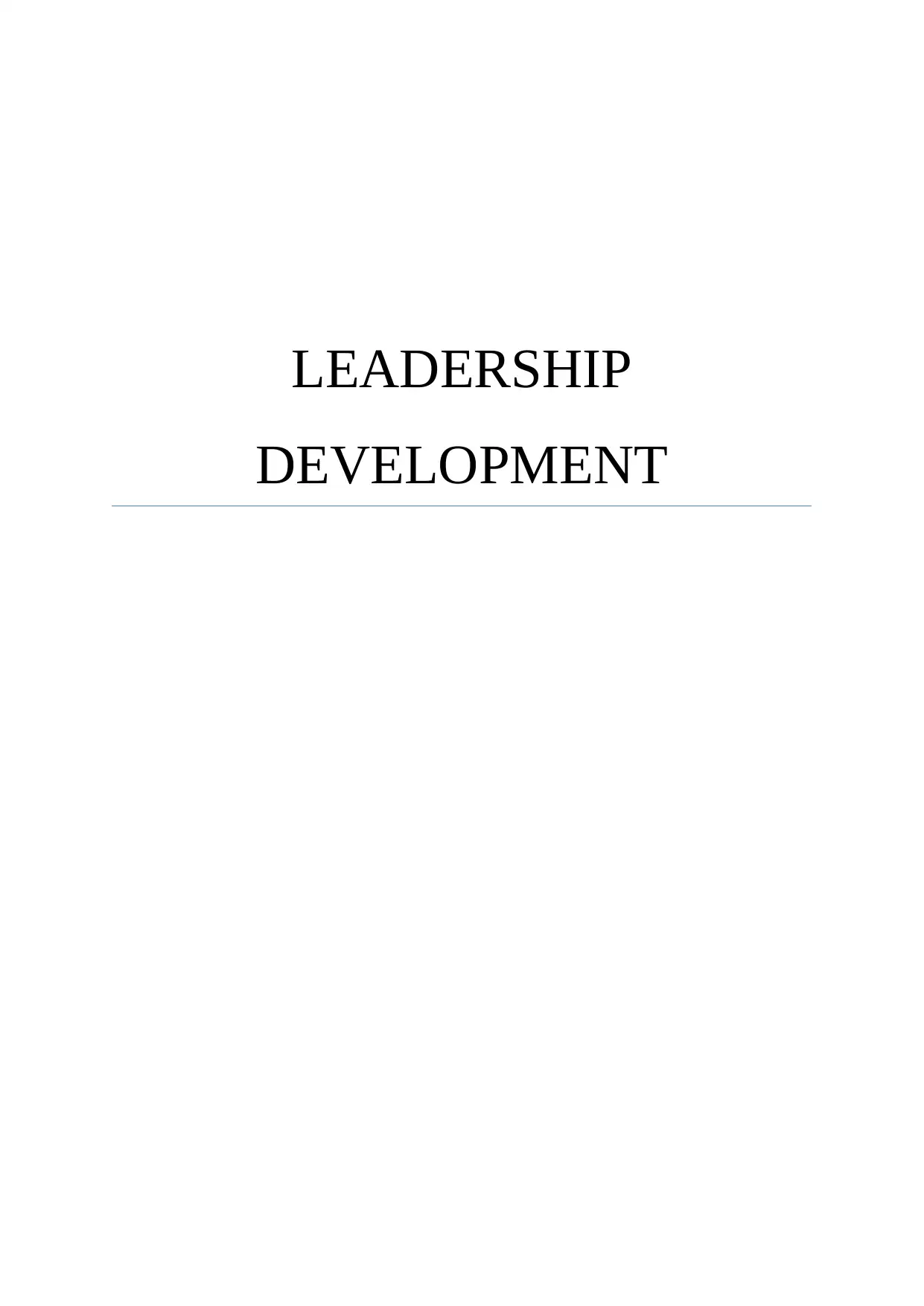
LEADERSHIP
DEVELOPMENT
DEVELOPMENT
Paraphrase This Document
Need a fresh take? Get an instant paraphrase of this document with our AI Paraphraser
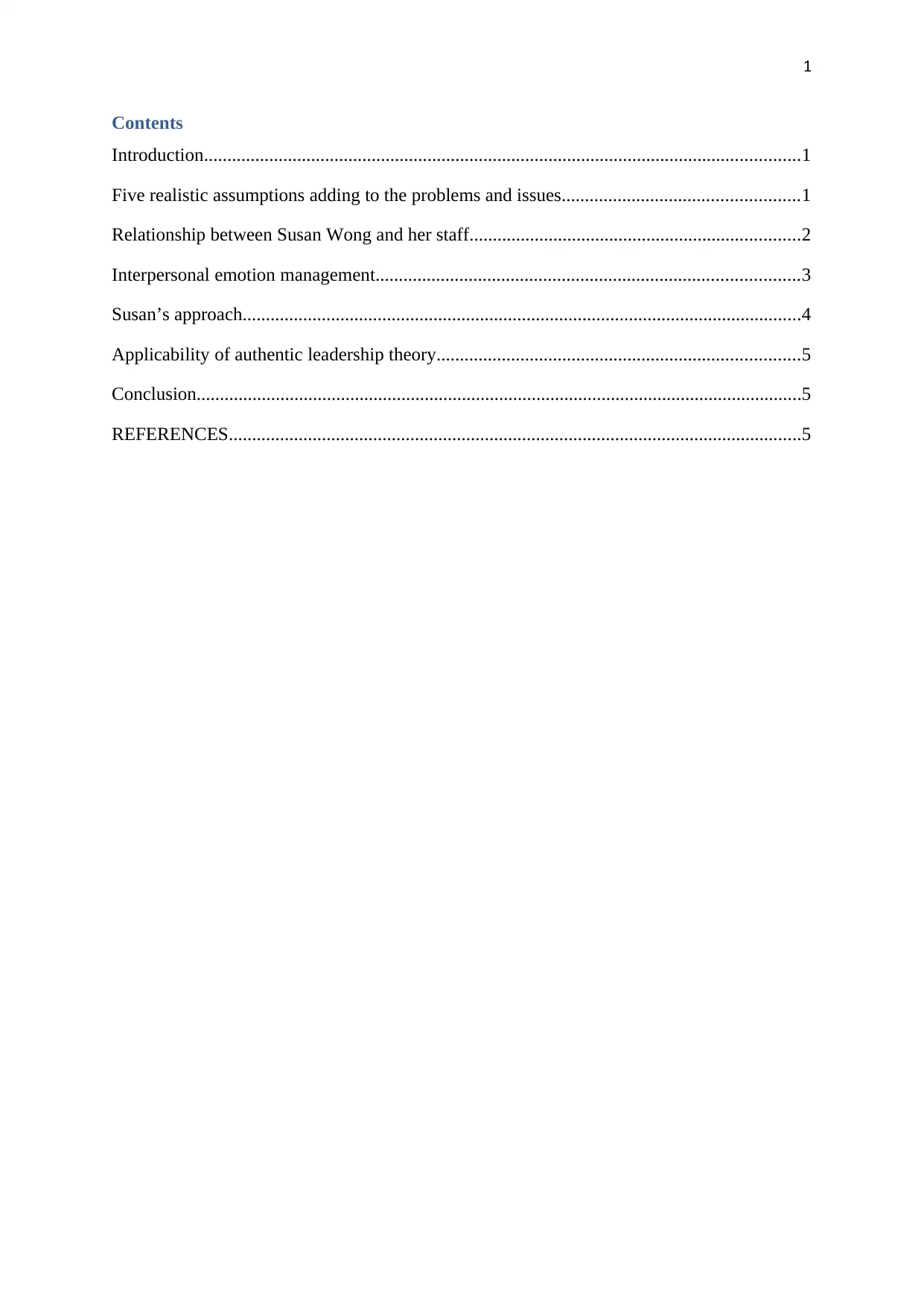
1
Contents
Introduction................................................................................................................................1
Five realistic assumptions adding to the problems and issues...................................................1
Relationship between Susan Wong and her staff.......................................................................2
Interpersonal emotion management...........................................................................................3
Susan’s approach........................................................................................................................4
Applicability of authentic leadership theory..............................................................................5
Conclusion..................................................................................................................................5
REFERENCES...........................................................................................................................5
Contents
Introduction................................................................................................................................1
Five realistic assumptions adding to the problems and issues...................................................1
Relationship between Susan Wong and her staff.......................................................................2
Interpersonal emotion management...........................................................................................3
Susan’s approach........................................................................................................................4
Applicability of authentic leadership theory..............................................................................5
Conclusion..................................................................................................................................5
REFERENCES...........................................................................................................................5
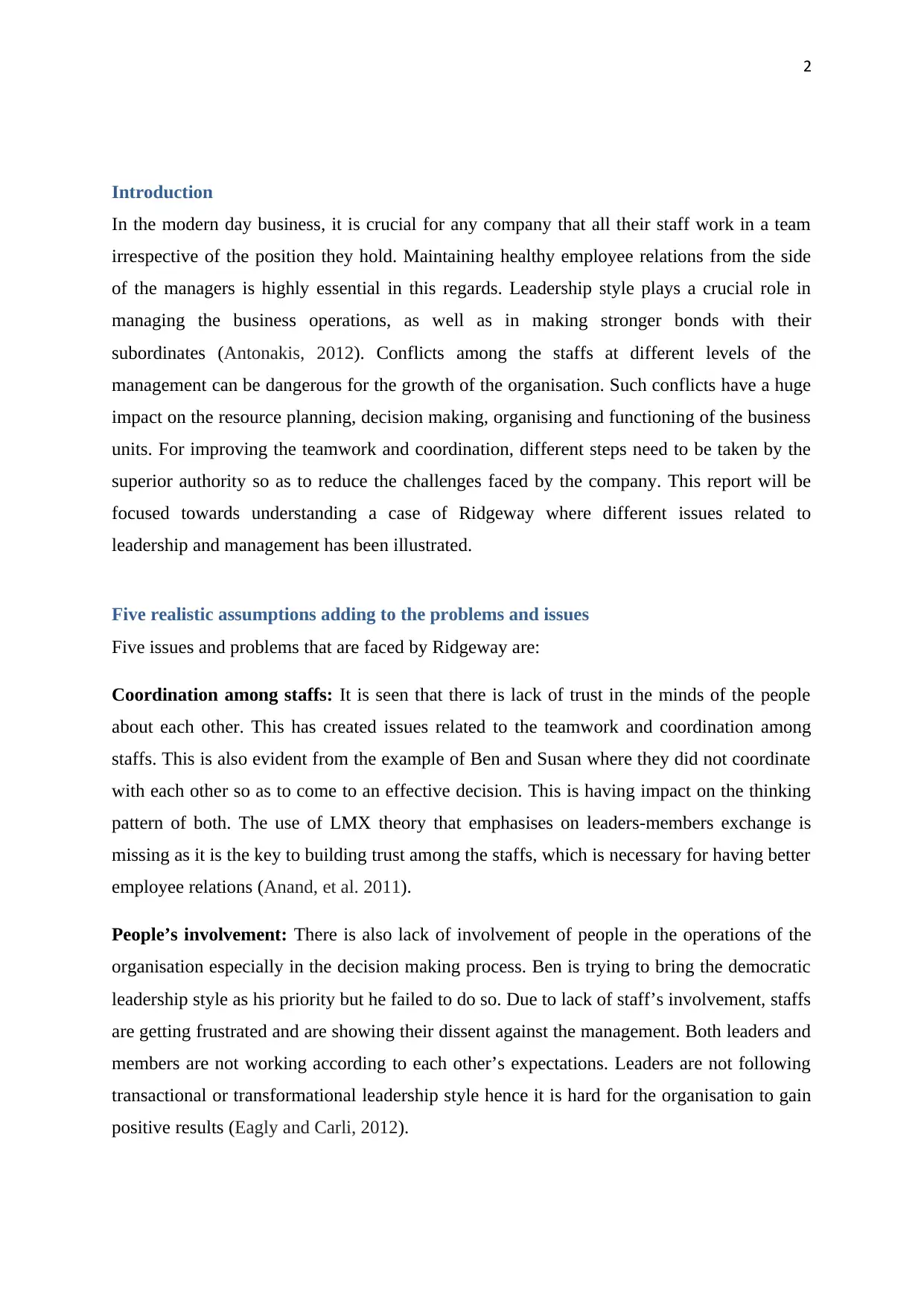
2
Introduction
In the modern day business, it is crucial for any company that all their staff work in a team
irrespective of the position they hold. Maintaining healthy employee relations from the side
of the managers is highly essential in this regards. Leadership style plays a crucial role in
managing the business operations, as well as in making stronger bonds with their
subordinates (Antonakis, 2012). Conflicts among the staffs at different levels of the
management can be dangerous for the growth of the organisation. Such conflicts have a huge
impact on the resource planning, decision making, organising and functioning of the business
units. For improving the teamwork and coordination, different steps need to be taken by the
superior authority so as to reduce the challenges faced by the company. This report will be
focused towards understanding a case of Ridgeway where different issues related to
leadership and management has been illustrated.
Five realistic assumptions adding to the problems and issues
Five issues and problems that are faced by Ridgeway are:
Coordination among staffs: It is seen that there is lack of trust in the minds of the people
about each other. This has created issues related to the teamwork and coordination among
staffs. This is also evident from the example of Ben and Susan where they did not coordinate
with each other so as to come to an effective decision. This is having impact on the thinking
pattern of both. The use of LMX theory that emphasises on leaders-members exchange is
missing as it is the key to building trust among the staffs, which is necessary for having better
employee relations (Anand, et al. 2011).
People’s involvement: There is also lack of involvement of people in the operations of the
organisation especially in the decision making process. Ben is trying to bring the democratic
leadership style as his priority but he failed to do so. Due to lack of staff’s involvement, staffs
are getting frustrated and are showing their dissent against the management. Both leaders and
members are not working according to each other’s expectations. Leaders are not following
transactional or transformational leadership style hence it is hard for the organisation to gain
positive results (Eagly and Carli, 2012).
Introduction
In the modern day business, it is crucial for any company that all their staff work in a team
irrespective of the position they hold. Maintaining healthy employee relations from the side
of the managers is highly essential in this regards. Leadership style plays a crucial role in
managing the business operations, as well as in making stronger bonds with their
subordinates (Antonakis, 2012). Conflicts among the staffs at different levels of the
management can be dangerous for the growth of the organisation. Such conflicts have a huge
impact on the resource planning, decision making, organising and functioning of the business
units. For improving the teamwork and coordination, different steps need to be taken by the
superior authority so as to reduce the challenges faced by the company. This report will be
focused towards understanding a case of Ridgeway where different issues related to
leadership and management has been illustrated.
Five realistic assumptions adding to the problems and issues
Five issues and problems that are faced by Ridgeway are:
Coordination among staffs: It is seen that there is lack of trust in the minds of the people
about each other. This has created issues related to the teamwork and coordination among
staffs. This is also evident from the example of Ben and Susan where they did not coordinate
with each other so as to come to an effective decision. This is having impact on the thinking
pattern of both. The use of LMX theory that emphasises on leaders-members exchange is
missing as it is the key to building trust among the staffs, which is necessary for having better
employee relations (Anand, et al. 2011).
People’s involvement: There is also lack of involvement of people in the operations of the
organisation especially in the decision making process. Ben is trying to bring the democratic
leadership style as his priority but he failed to do so. Due to lack of staff’s involvement, staffs
are getting frustrated and are showing their dissent against the management. Both leaders and
members are not working according to each other’s expectations. Leaders are not following
transactional or transformational leadership style hence it is hard for the organisation to gain
positive results (Eagly and Carli, 2012).
⊘ This is a preview!⊘
Do you want full access?
Subscribe today to unlock all pages.

Trusted by 1+ million students worldwide
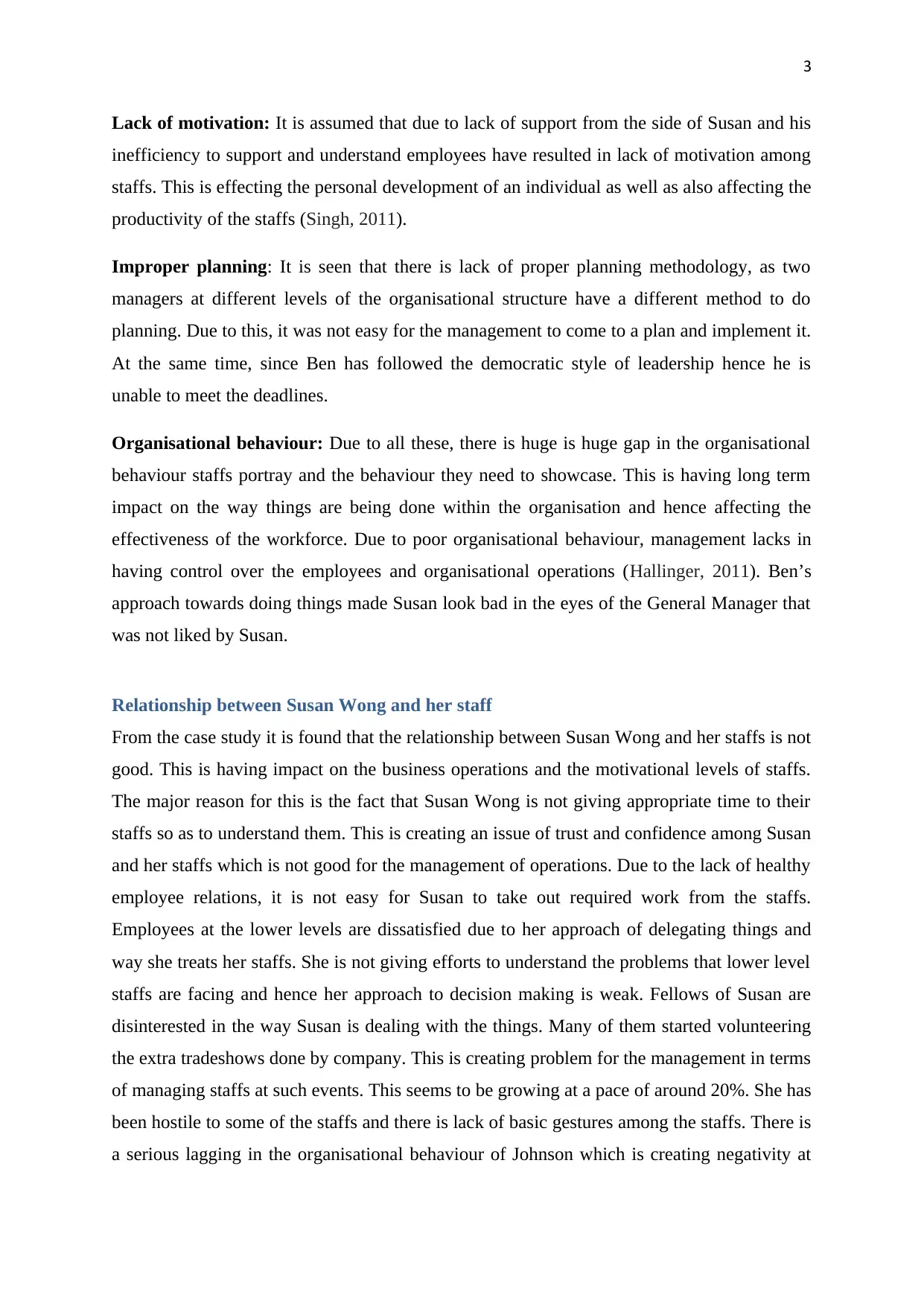
3
Lack of motivation: It is assumed that due to lack of support from the side of Susan and his
inefficiency to support and understand employees have resulted in lack of motivation among
staffs. This is effecting the personal development of an individual as well as also affecting the
productivity of the staffs (Singh, 2011).
Improper planning: It is seen that there is lack of proper planning methodology, as two
managers at different levels of the organisational structure have a different method to do
planning. Due to this, it was not easy for the management to come to a plan and implement it.
At the same time, since Ben has followed the democratic style of leadership hence he is
unable to meet the deadlines.
Organisational behaviour: Due to all these, there is huge is huge gap in the organisational
behaviour staffs portray and the behaviour they need to showcase. This is having long term
impact on the way things are being done within the organisation and hence affecting the
effectiveness of the workforce. Due to poor organisational behaviour, management lacks in
having control over the employees and organisational operations (Hallinger, 2011). Ben’s
approach towards doing things made Susan look bad in the eyes of the General Manager that
was not liked by Susan.
Relationship between Susan Wong and her staff
From the case study it is found that the relationship between Susan Wong and her staffs is not
good. This is having impact on the business operations and the motivational levels of staffs.
The major reason for this is the fact that Susan Wong is not giving appropriate time to their
staffs so as to understand them. This is creating an issue of trust and confidence among Susan
and her staffs which is not good for the management of operations. Due to the lack of healthy
employee relations, it is not easy for Susan to take out required work from the staffs.
Employees at the lower levels are dissatisfied due to her approach of delegating things and
way she treats her staffs. She is not giving efforts to understand the problems that lower level
staffs are facing and hence her approach to decision making is weak. Fellows of Susan are
disinterested in the way Susan is dealing with the things. Many of them started volunteering
the extra tradeshows done by company. This is creating problem for the management in terms
of managing staffs at such events. This seems to be growing at a pace of around 20%. She has
been hostile to some of the staffs and there is lack of basic gestures among the staffs. There is
a serious lagging in the organisational behaviour of Johnson which is creating negativity at
Lack of motivation: It is assumed that due to lack of support from the side of Susan and his
inefficiency to support and understand employees have resulted in lack of motivation among
staffs. This is effecting the personal development of an individual as well as also affecting the
productivity of the staffs (Singh, 2011).
Improper planning: It is seen that there is lack of proper planning methodology, as two
managers at different levels of the organisational structure have a different method to do
planning. Due to this, it was not easy for the management to come to a plan and implement it.
At the same time, since Ben has followed the democratic style of leadership hence he is
unable to meet the deadlines.
Organisational behaviour: Due to all these, there is huge is huge gap in the organisational
behaviour staffs portray and the behaviour they need to showcase. This is having long term
impact on the way things are being done within the organisation and hence affecting the
effectiveness of the workforce. Due to poor organisational behaviour, management lacks in
having control over the employees and organisational operations (Hallinger, 2011). Ben’s
approach towards doing things made Susan look bad in the eyes of the General Manager that
was not liked by Susan.
Relationship between Susan Wong and her staff
From the case study it is found that the relationship between Susan Wong and her staffs is not
good. This is having impact on the business operations and the motivational levels of staffs.
The major reason for this is the fact that Susan Wong is not giving appropriate time to their
staffs so as to understand them. This is creating an issue of trust and confidence among Susan
and her staffs which is not good for the management of operations. Due to the lack of healthy
employee relations, it is not easy for Susan to take out required work from the staffs.
Employees at the lower levels are dissatisfied due to her approach of delegating things and
way she treats her staffs. She is not giving efforts to understand the problems that lower level
staffs are facing and hence her approach to decision making is weak. Fellows of Susan are
disinterested in the way Susan is dealing with the things. Many of them started volunteering
the extra tradeshows done by company. This is creating problem for the management in terms
of managing staffs at such events. This seems to be growing at a pace of around 20%. She has
been hostile to some of the staffs and there is lack of basic gestures among the staffs. There is
a serious lagging in the organisational behaviour of Johnson which is creating negativity at
Paraphrase This Document
Need a fresh take? Get an instant paraphrase of this document with our AI Paraphraser
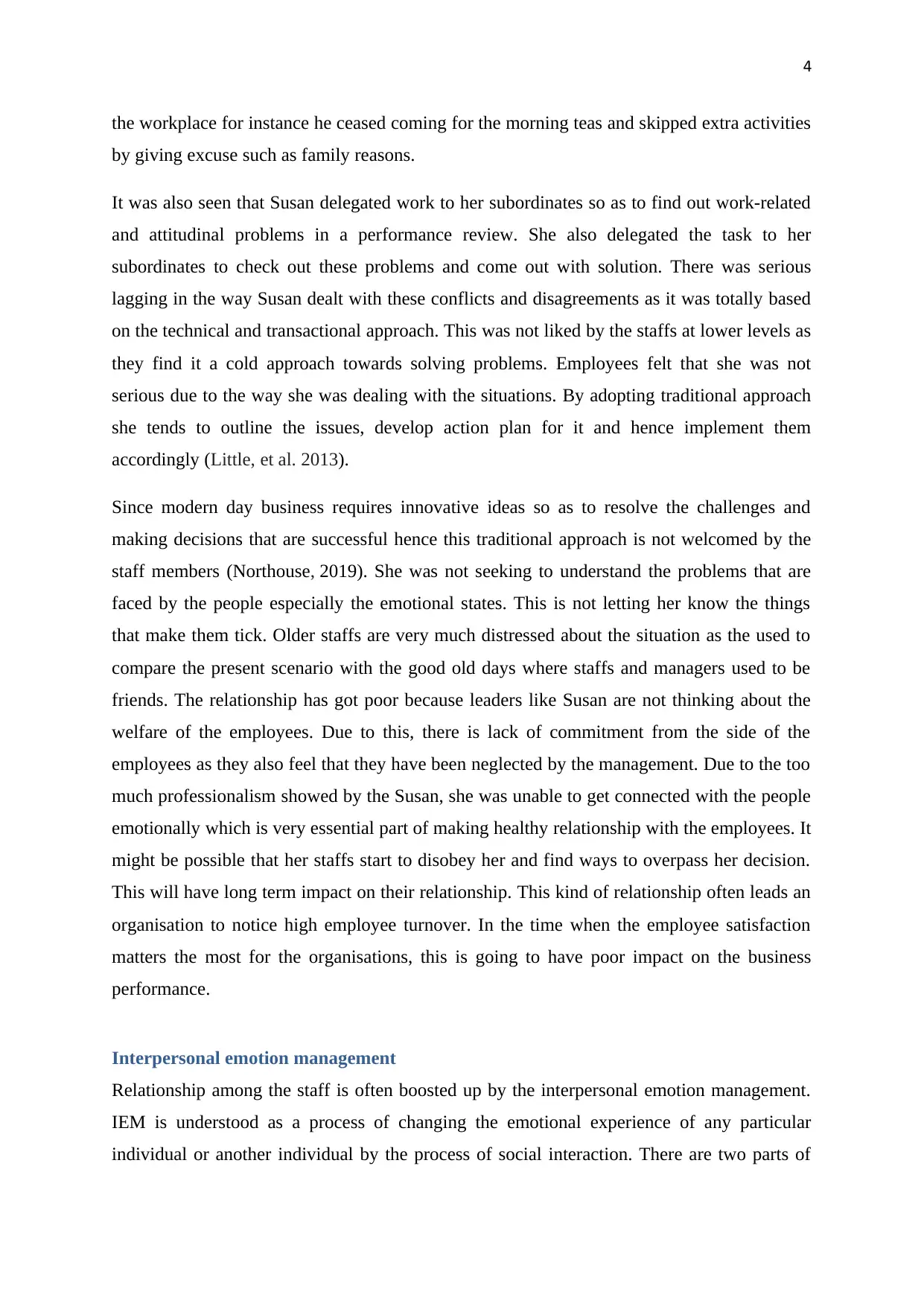
4
the workplace for instance he ceased coming for the morning teas and skipped extra activities
by giving excuse such as family reasons.
It was also seen that Susan delegated work to her subordinates so as to find out work-related
and attitudinal problems in a performance review. She also delegated the task to her
subordinates to check out these problems and come out with solution. There was serious
lagging in the way Susan dealt with these conflicts and disagreements as it was totally based
on the technical and transactional approach. This was not liked by the staffs at lower levels as
they find it a cold approach towards solving problems. Employees felt that she was not
serious due to the way she was dealing with the situations. By adopting traditional approach
she tends to outline the issues, develop action plan for it and hence implement them
accordingly (Little, et al. 2013).
Since modern day business requires innovative ideas so as to resolve the challenges and
making decisions that are successful hence this traditional approach is not welcomed by the
staff members (Northouse, 2019). She was not seeking to understand the problems that are
faced by the people especially the emotional states. This is not letting her know the things
that make them tick. Older staffs are very much distressed about the situation as the used to
compare the present scenario with the good old days where staffs and managers used to be
friends. The relationship has got poor because leaders like Susan are not thinking about the
welfare of the employees. Due to this, there is lack of commitment from the side of the
employees as they also feel that they have been neglected by the management. Due to the too
much professionalism showed by the Susan, she was unable to get connected with the people
emotionally which is very essential part of making healthy relationship with the employees. It
might be possible that her staffs start to disobey her and find ways to overpass her decision.
This will have long term impact on their relationship. This kind of relationship often leads an
organisation to notice high employee turnover. In the time when the employee satisfaction
matters the most for the organisations, this is going to have poor impact on the business
performance.
Interpersonal emotion management
Relationship among the staff is often boosted up by the interpersonal emotion management.
IEM is understood as a process of changing the emotional experience of any particular
individual or another individual by the process of social interaction. There are two parts of
the workplace for instance he ceased coming for the morning teas and skipped extra activities
by giving excuse such as family reasons.
It was also seen that Susan delegated work to her subordinates so as to find out work-related
and attitudinal problems in a performance review. She also delegated the task to her
subordinates to check out these problems and come out with solution. There was serious
lagging in the way Susan dealt with these conflicts and disagreements as it was totally based
on the technical and transactional approach. This was not liked by the staffs at lower levels as
they find it a cold approach towards solving problems. Employees felt that she was not
serious due to the way she was dealing with the situations. By adopting traditional approach
she tends to outline the issues, develop action plan for it and hence implement them
accordingly (Little, et al. 2013).
Since modern day business requires innovative ideas so as to resolve the challenges and
making decisions that are successful hence this traditional approach is not welcomed by the
staff members (Northouse, 2019). She was not seeking to understand the problems that are
faced by the people especially the emotional states. This is not letting her know the things
that make them tick. Older staffs are very much distressed about the situation as the used to
compare the present scenario with the good old days where staffs and managers used to be
friends. The relationship has got poor because leaders like Susan are not thinking about the
welfare of the employees. Due to this, there is lack of commitment from the side of the
employees as they also feel that they have been neglected by the management. Due to the too
much professionalism showed by the Susan, she was unable to get connected with the people
emotionally which is very essential part of making healthy relationship with the employees. It
might be possible that her staffs start to disobey her and find ways to overpass her decision.
This will have long term impact on their relationship. This kind of relationship often leads an
organisation to notice high employee turnover. In the time when the employee satisfaction
matters the most for the organisations, this is going to have poor impact on the business
performance.
Interpersonal emotion management
Relationship among the staff is often boosted up by the interpersonal emotion management.
IEM is understood as a process of changing the emotional experience of any particular
individual or another individual by the process of social interaction. There are two parts of
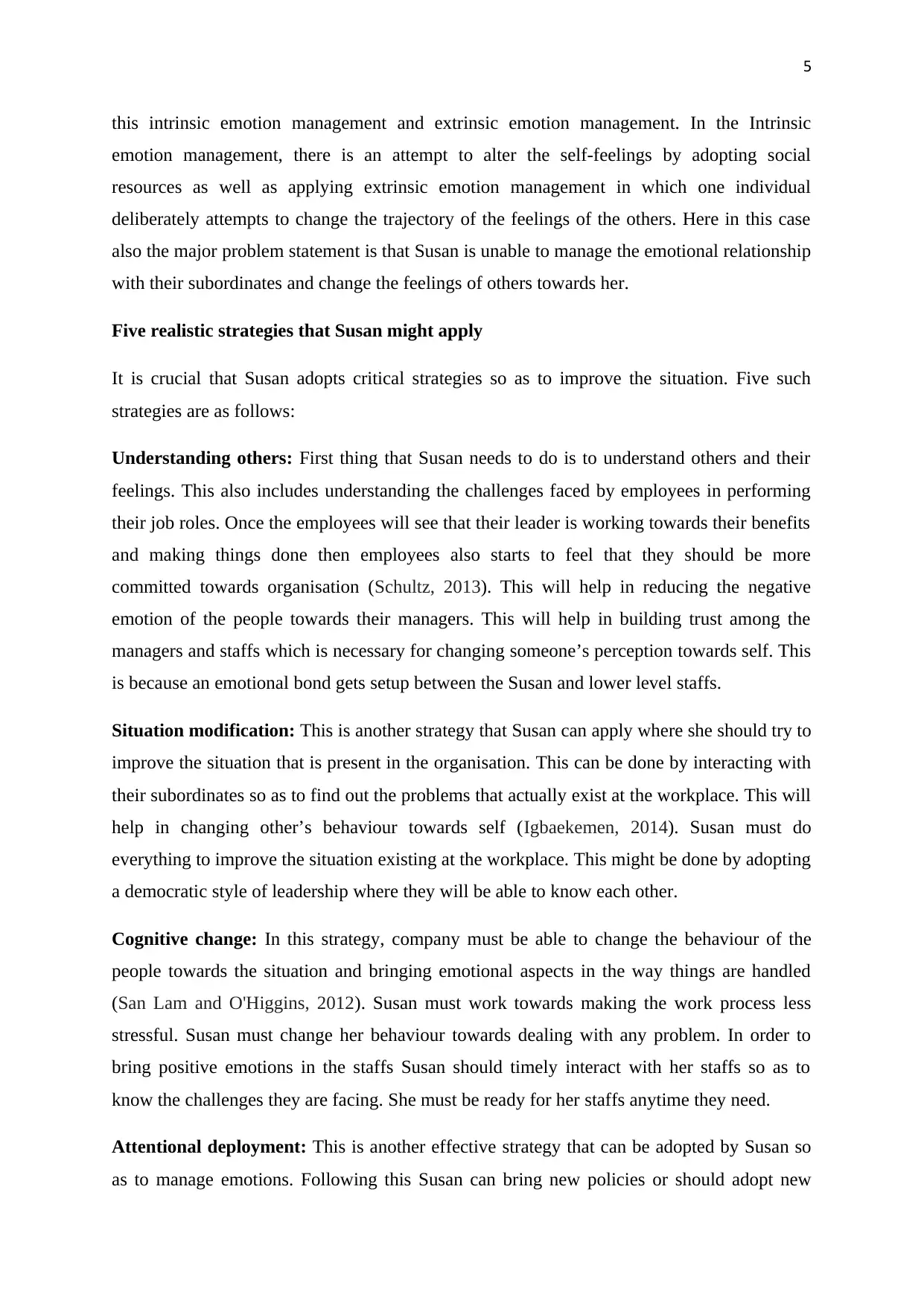
5
this intrinsic emotion management and extrinsic emotion management. In the Intrinsic
emotion management, there is an attempt to alter the self-feelings by adopting social
resources as well as applying extrinsic emotion management in which one individual
deliberately attempts to change the trajectory of the feelings of the others. Here in this case
also the major problem statement is that Susan is unable to manage the emotional relationship
with their subordinates and change the feelings of others towards her.
Five realistic strategies that Susan might apply
It is crucial that Susan adopts critical strategies so as to improve the situation. Five such
strategies are as follows:
Understanding others: First thing that Susan needs to do is to understand others and their
feelings. This also includes understanding the challenges faced by employees in performing
their job roles. Once the employees will see that their leader is working towards their benefits
and making things done then employees also starts to feel that they should be more
committed towards organisation (Schultz, 2013). This will help in reducing the negative
emotion of the people towards their managers. This will help in building trust among the
managers and staffs which is necessary for changing someone’s perception towards self. This
is because an emotional bond gets setup between the Susan and lower level staffs.
Situation modification: This is another strategy that Susan can apply where she should try to
improve the situation that is present in the organisation. This can be done by interacting with
their subordinates so as to find out the problems that actually exist at the workplace. This will
help in changing other’s behaviour towards self (Igbaekemen, 2014). Susan must do
everything to improve the situation existing at the workplace. This might be done by adopting
a democratic style of leadership where they will be able to know each other.
Cognitive change: In this strategy, company must be able to change the behaviour of the
people towards the situation and bringing emotional aspects in the way things are handled
(San Lam and O'Higgins, 2012). Susan must work towards making the work process less
stressful. Susan must change her behaviour towards dealing with any problem. In order to
bring positive emotions in the staffs Susan should timely interact with her staffs so as to
know the challenges they are facing. She must be ready for her staffs anytime they need.
Attentional deployment: This is another effective strategy that can be adopted by Susan so
as to manage emotions. Following this Susan can bring new policies or should adopt new
this intrinsic emotion management and extrinsic emotion management. In the Intrinsic
emotion management, there is an attempt to alter the self-feelings by adopting social
resources as well as applying extrinsic emotion management in which one individual
deliberately attempts to change the trajectory of the feelings of the others. Here in this case
also the major problem statement is that Susan is unable to manage the emotional relationship
with their subordinates and change the feelings of others towards her.
Five realistic strategies that Susan might apply
It is crucial that Susan adopts critical strategies so as to improve the situation. Five such
strategies are as follows:
Understanding others: First thing that Susan needs to do is to understand others and their
feelings. This also includes understanding the challenges faced by employees in performing
their job roles. Once the employees will see that their leader is working towards their benefits
and making things done then employees also starts to feel that they should be more
committed towards organisation (Schultz, 2013). This will help in reducing the negative
emotion of the people towards their managers. This will help in building trust among the
managers and staffs which is necessary for changing someone’s perception towards self. This
is because an emotional bond gets setup between the Susan and lower level staffs.
Situation modification: This is another strategy that Susan can apply where she should try to
improve the situation that is present in the organisation. This can be done by interacting with
their subordinates so as to find out the problems that actually exist at the workplace. This will
help in changing other’s behaviour towards self (Igbaekemen, 2014). Susan must do
everything to improve the situation existing at the workplace. This might be done by adopting
a democratic style of leadership where they will be able to know each other.
Cognitive change: In this strategy, company must be able to change the behaviour of the
people towards the situation and bringing emotional aspects in the way things are handled
(San Lam and O'Higgins, 2012). Susan must work towards making the work process less
stressful. Susan must change her behaviour towards dealing with any problem. In order to
bring positive emotions in the staffs Susan should timely interact with her staffs so as to
know the challenges they are facing. She must be ready for her staffs anytime they need.
Attentional deployment: This is another effective strategy that can be adopted by Susan so
as to manage emotions. Following this Susan can bring new policies or should adopt new
⊘ This is a preview!⊘
Do you want full access?
Subscribe today to unlock all pages.

Trusted by 1+ million students worldwide
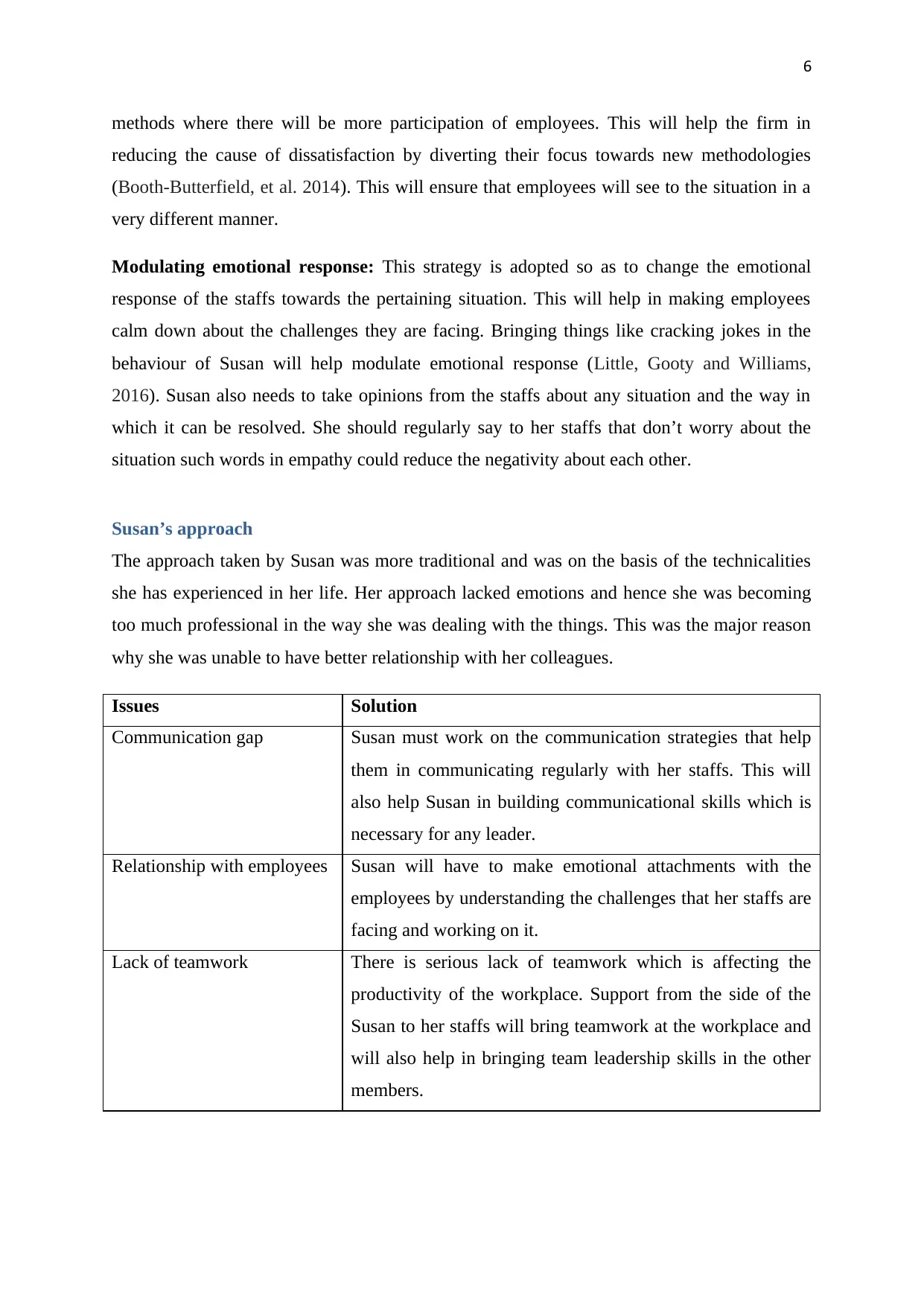
6
methods where there will be more participation of employees. This will help the firm in
reducing the cause of dissatisfaction by diverting their focus towards new methodologies
(Booth-Butterfield, et al. 2014). This will ensure that employees will see to the situation in a
very different manner.
Modulating emotional response: This strategy is adopted so as to change the emotional
response of the staffs towards the pertaining situation. This will help in making employees
calm down about the challenges they are facing. Bringing things like cracking jokes in the
behaviour of Susan will help modulate emotional response (Little, Gooty and Williams,
2016). Susan also needs to take opinions from the staffs about any situation and the way in
which it can be resolved. She should regularly say to her staffs that don’t worry about the
situation such words in empathy could reduce the negativity about each other.
Susan’s approach
The approach taken by Susan was more traditional and was on the basis of the technicalities
she has experienced in her life. Her approach lacked emotions and hence she was becoming
too much professional in the way she was dealing with the things. This was the major reason
why she was unable to have better relationship with her colleagues.
Issues Solution
Communication gap Susan must work on the communication strategies that help
them in communicating regularly with her staffs. This will
also help Susan in building communicational skills which is
necessary for any leader.
Relationship with employees Susan will have to make emotional attachments with the
employees by understanding the challenges that her staffs are
facing and working on it.
Lack of teamwork There is serious lack of teamwork which is affecting the
productivity of the workplace. Support from the side of the
Susan to her staffs will bring teamwork at the workplace and
will also help in bringing team leadership skills in the other
members.
methods where there will be more participation of employees. This will help the firm in
reducing the cause of dissatisfaction by diverting their focus towards new methodologies
(Booth-Butterfield, et al. 2014). This will ensure that employees will see to the situation in a
very different manner.
Modulating emotional response: This strategy is adopted so as to change the emotional
response of the staffs towards the pertaining situation. This will help in making employees
calm down about the challenges they are facing. Bringing things like cracking jokes in the
behaviour of Susan will help modulate emotional response (Little, Gooty and Williams,
2016). Susan also needs to take opinions from the staffs about any situation and the way in
which it can be resolved. She should regularly say to her staffs that don’t worry about the
situation such words in empathy could reduce the negativity about each other.
Susan’s approach
The approach taken by Susan was more traditional and was on the basis of the technicalities
she has experienced in her life. Her approach lacked emotions and hence she was becoming
too much professional in the way she was dealing with the things. This was the major reason
why she was unable to have better relationship with her colleagues.
Issues Solution
Communication gap Susan must work on the communication strategies that help
them in communicating regularly with her staffs. This will
also help Susan in building communicational skills which is
necessary for any leader.
Relationship with employees Susan will have to make emotional attachments with the
employees by understanding the challenges that her staffs are
facing and working on it.
Lack of teamwork There is serious lack of teamwork which is affecting the
productivity of the workplace. Support from the side of the
Susan to her staffs will bring teamwork at the workplace and
will also help in bringing team leadership skills in the other
members.
Paraphrase This Document
Need a fresh take? Get an instant paraphrase of this document with our AI Paraphraser
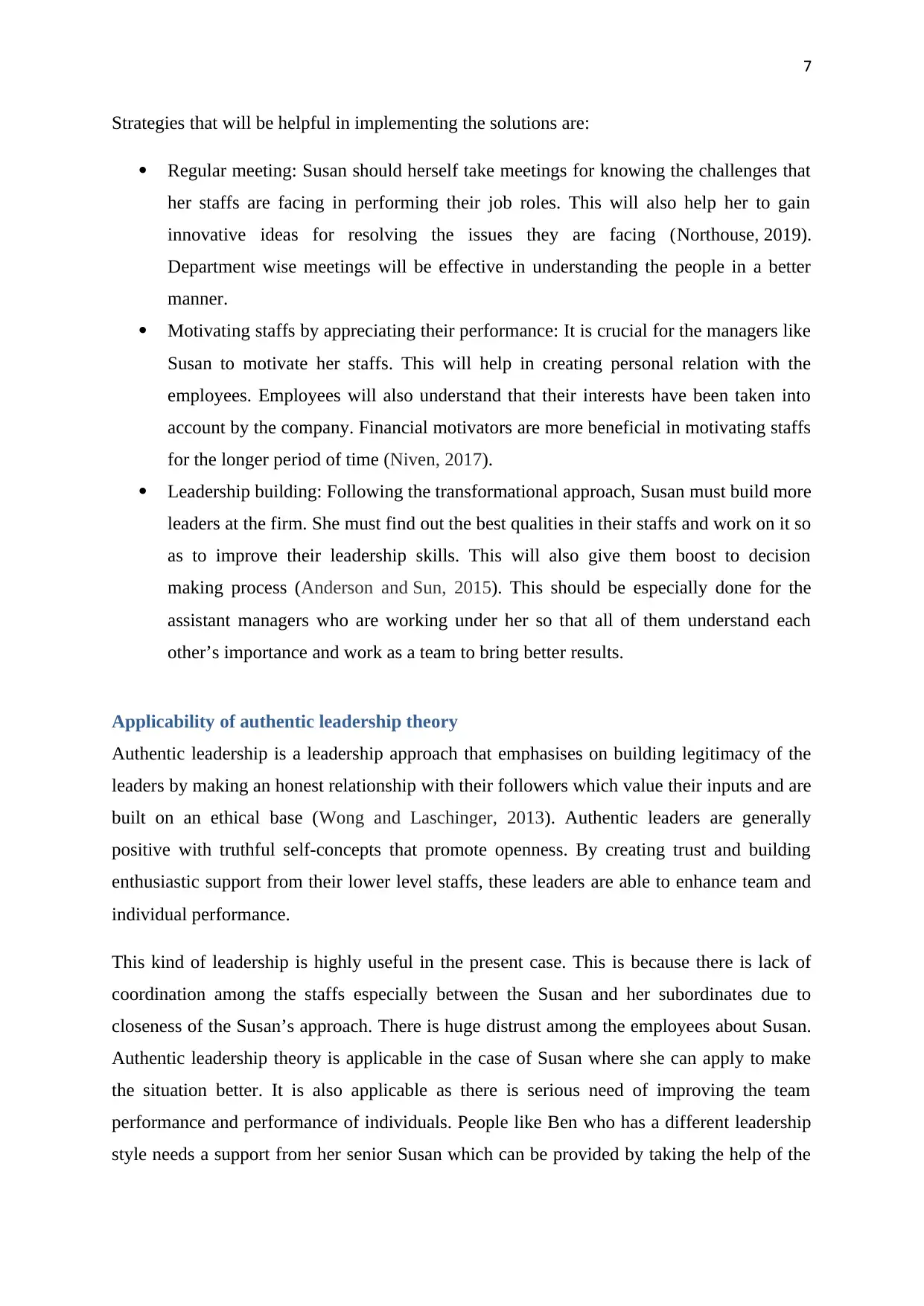
7
Strategies that will be helpful in implementing the solutions are:
Regular meeting: Susan should herself take meetings for knowing the challenges that
her staffs are facing in performing their job roles. This will also help her to gain
innovative ideas for resolving the issues they are facing (Northouse, 2019).
Department wise meetings will be effective in understanding the people in a better
manner.
Motivating staffs by appreciating their performance: It is crucial for the managers like
Susan to motivate her staffs. This will help in creating personal relation with the
employees. Employees will also understand that their interests have been taken into
account by the company. Financial motivators are more beneficial in motivating staffs
for the longer period of time (Niven, 2017).
Leadership building: Following the transformational approach, Susan must build more
leaders at the firm. She must find out the best qualities in their staffs and work on it so
as to improve their leadership skills. This will also give them boost to decision
making process (Anderson and Sun, 2015). This should be especially done for the
assistant managers who are working under her so that all of them understand each
other’s importance and work as a team to bring better results.
Applicability of authentic leadership theory
Authentic leadership is a leadership approach that emphasises on building legitimacy of the
leaders by making an honest relationship with their followers which value their inputs and are
built on an ethical base (Wong and Laschinger, 2013). Authentic leaders are generally
positive with truthful self-concepts that promote openness. By creating trust and building
enthusiastic support from their lower level staffs, these leaders are able to enhance team and
individual performance.
This kind of leadership is highly useful in the present case. This is because there is lack of
coordination among the staffs especially between the Susan and her subordinates due to
closeness of the Susan’s approach. There is huge distrust among the employees about Susan.
Authentic leadership theory is applicable in the case of Susan where she can apply to make
the situation better. It is also applicable as there is serious need of improving the team
performance and performance of individuals. People like Ben who has a different leadership
style needs a support from her senior Susan which can be provided by taking the help of the
Strategies that will be helpful in implementing the solutions are:
Regular meeting: Susan should herself take meetings for knowing the challenges that
her staffs are facing in performing their job roles. This will also help her to gain
innovative ideas for resolving the issues they are facing (Northouse, 2019).
Department wise meetings will be effective in understanding the people in a better
manner.
Motivating staffs by appreciating their performance: It is crucial for the managers like
Susan to motivate her staffs. This will help in creating personal relation with the
employees. Employees will also understand that their interests have been taken into
account by the company. Financial motivators are more beneficial in motivating staffs
for the longer period of time (Niven, 2017).
Leadership building: Following the transformational approach, Susan must build more
leaders at the firm. She must find out the best qualities in their staffs and work on it so
as to improve their leadership skills. This will also give them boost to decision
making process (Anderson and Sun, 2015). This should be especially done for the
assistant managers who are working under her so that all of them understand each
other’s importance and work as a team to bring better results.
Applicability of authentic leadership theory
Authentic leadership is a leadership approach that emphasises on building legitimacy of the
leaders by making an honest relationship with their followers which value their inputs and are
built on an ethical base (Wong and Laschinger, 2013). Authentic leaders are generally
positive with truthful self-concepts that promote openness. By creating trust and building
enthusiastic support from their lower level staffs, these leaders are able to enhance team and
individual performance.
This kind of leadership is highly useful in the present case. This is because there is lack of
coordination among the staffs especially between the Susan and her subordinates due to
closeness of the Susan’s approach. There is huge distrust among the employees about Susan.
Authentic leadership theory is applicable in the case of Susan where she can apply to make
the situation better. It is also applicable as there is serious need of improving the team
performance and performance of individuals. People like Ben who has a different leadership
style needs a support from her senior Susan which can be provided by taking the help of the
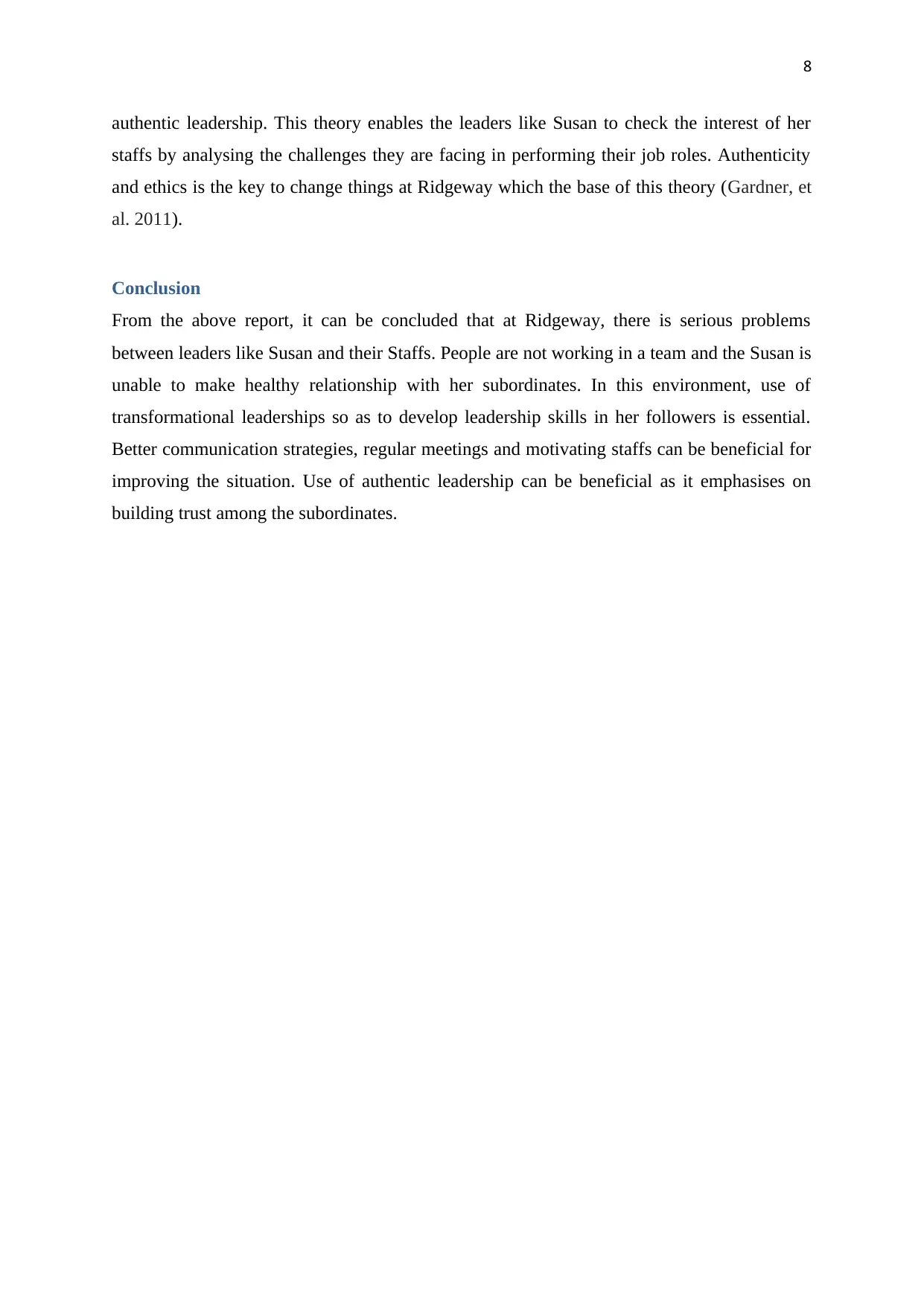
8
authentic leadership. This theory enables the leaders like Susan to check the interest of her
staffs by analysing the challenges they are facing in performing their job roles. Authenticity
and ethics is the key to change things at Ridgeway which the base of this theory (Gardner, et
al. 2011).
Conclusion
From the above report, it can be concluded that at Ridgeway, there is serious problems
between leaders like Susan and their Staffs. People are not working in a team and the Susan is
unable to make healthy relationship with her subordinates. In this environment, use of
transformational leaderships so as to develop leadership skills in her followers is essential.
Better communication strategies, regular meetings and motivating staffs can be beneficial for
improving the situation. Use of authentic leadership can be beneficial as it emphasises on
building trust among the subordinates.
authentic leadership. This theory enables the leaders like Susan to check the interest of her
staffs by analysing the challenges they are facing in performing their job roles. Authenticity
and ethics is the key to change things at Ridgeway which the base of this theory (Gardner, et
al. 2011).
Conclusion
From the above report, it can be concluded that at Ridgeway, there is serious problems
between leaders like Susan and their Staffs. People are not working in a team and the Susan is
unable to make healthy relationship with her subordinates. In this environment, use of
transformational leaderships so as to develop leadership skills in her followers is essential.
Better communication strategies, regular meetings and motivating staffs can be beneficial for
improving the situation. Use of authentic leadership can be beneficial as it emphasises on
building trust among the subordinates.
⊘ This is a preview!⊘
Do you want full access?
Subscribe today to unlock all pages.

Trusted by 1+ million students worldwide
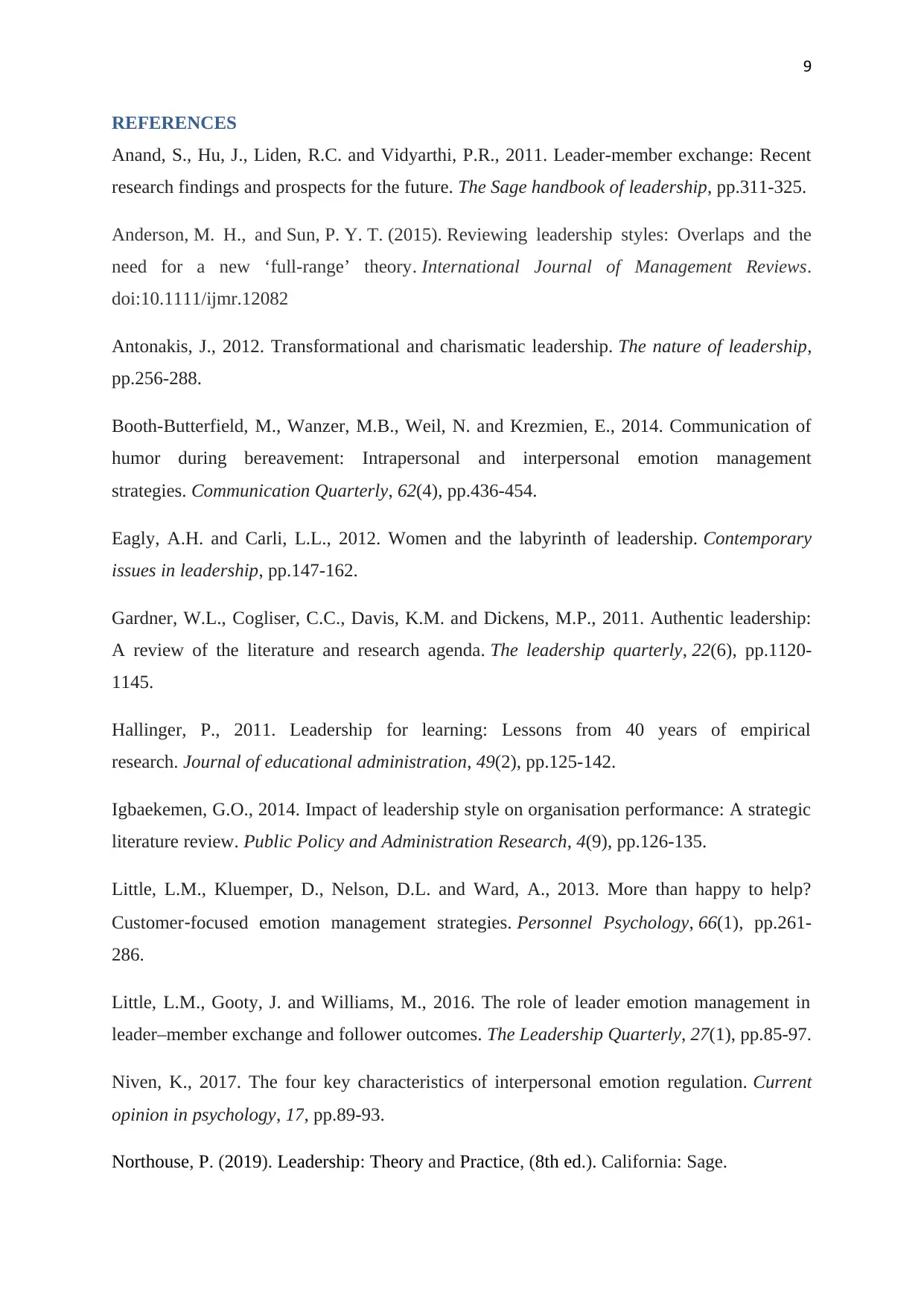
9
REFERENCES
Anand, S., Hu, J., Liden, R.C. and Vidyarthi, P.R., 2011. Leader-member exchange: Recent
research findings and prospects for the future. The Sage handbook of leadership, pp.311-325.
Anderson, M. H., and Sun, P. Y. T. (2015). Reviewing leadership styles: Overlaps and the
need for a new ‘full-range’ theory. International Journal of Management Reviews.
doi:10.1111/ijmr.12082
Antonakis, J., 2012. Transformational and charismatic leadership. The nature of leadership,
pp.256-288.
Booth-Butterfield, M., Wanzer, M.B., Weil, N. and Krezmien, E., 2014. Communication of
humor during bereavement: Intrapersonal and interpersonal emotion management
strategies. Communication Quarterly, 62(4), pp.436-454.
Eagly, A.H. and Carli, L.L., 2012. Women and the labyrinth of leadership. Contemporary
issues in leadership, pp.147-162.
Gardner, W.L., Cogliser, C.C., Davis, K.M. and Dickens, M.P., 2011. Authentic leadership:
A review of the literature and research agenda. The leadership quarterly, 22(6), pp.1120-
1145.
Hallinger, P., 2011. Leadership for learning: Lessons from 40 years of empirical
research. Journal of educational administration, 49(2), pp.125-142.
Igbaekemen, G.O., 2014. Impact of leadership style on organisation performance: A strategic
literature review. Public Policy and Administration Research, 4(9), pp.126-135.
Little, L.M., Kluemper, D., Nelson, D.L. and Ward, A., 2013. More than happy to help?
Customer‐focused emotion management strategies. Personnel Psychology, 66(1), pp.261-
286.
Little, L.M., Gooty, J. and Williams, M., 2016. The role of leader emotion management in
leader–member exchange and follower outcomes. The Leadership Quarterly, 27(1), pp.85-97.
Niven, K., 2017. The four key characteristics of interpersonal emotion regulation. Current
opinion in psychology, 17, pp.89-93.
Northouse, P. (2019). Leadership: Theory and Practice, (8th ed.). California: Sage.
REFERENCES
Anand, S., Hu, J., Liden, R.C. and Vidyarthi, P.R., 2011. Leader-member exchange: Recent
research findings and prospects for the future. The Sage handbook of leadership, pp.311-325.
Anderson, M. H., and Sun, P. Y. T. (2015). Reviewing leadership styles: Overlaps and the
need for a new ‘full-range’ theory. International Journal of Management Reviews.
doi:10.1111/ijmr.12082
Antonakis, J., 2012. Transformational and charismatic leadership. The nature of leadership,
pp.256-288.
Booth-Butterfield, M., Wanzer, M.B., Weil, N. and Krezmien, E., 2014. Communication of
humor during bereavement: Intrapersonal and interpersonal emotion management
strategies. Communication Quarterly, 62(4), pp.436-454.
Eagly, A.H. and Carli, L.L., 2012. Women and the labyrinth of leadership. Contemporary
issues in leadership, pp.147-162.
Gardner, W.L., Cogliser, C.C., Davis, K.M. and Dickens, M.P., 2011. Authentic leadership:
A review of the literature and research agenda. The leadership quarterly, 22(6), pp.1120-
1145.
Hallinger, P., 2011. Leadership for learning: Lessons from 40 years of empirical
research. Journal of educational administration, 49(2), pp.125-142.
Igbaekemen, G.O., 2014. Impact of leadership style on organisation performance: A strategic
literature review. Public Policy and Administration Research, 4(9), pp.126-135.
Little, L.M., Kluemper, D., Nelson, D.L. and Ward, A., 2013. More than happy to help?
Customer‐focused emotion management strategies. Personnel Psychology, 66(1), pp.261-
286.
Little, L.M., Gooty, J. and Williams, M., 2016. The role of leader emotion management in
leader–member exchange and follower outcomes. The Leadership Quarterly, 27(1), pp.85-97.
Niven, K., 2017. The four key characteristics of interpersonal emotion regulation. Current
opinion in psychology, 17, pp.89-93.
Northouse, P. (2019). Leadership: Theory and Practice, (8th ed.). California: Sage.
Paraphrase This Document
Need a fresh take? Get an instant paraphrase of this document with our AI Paraphraser
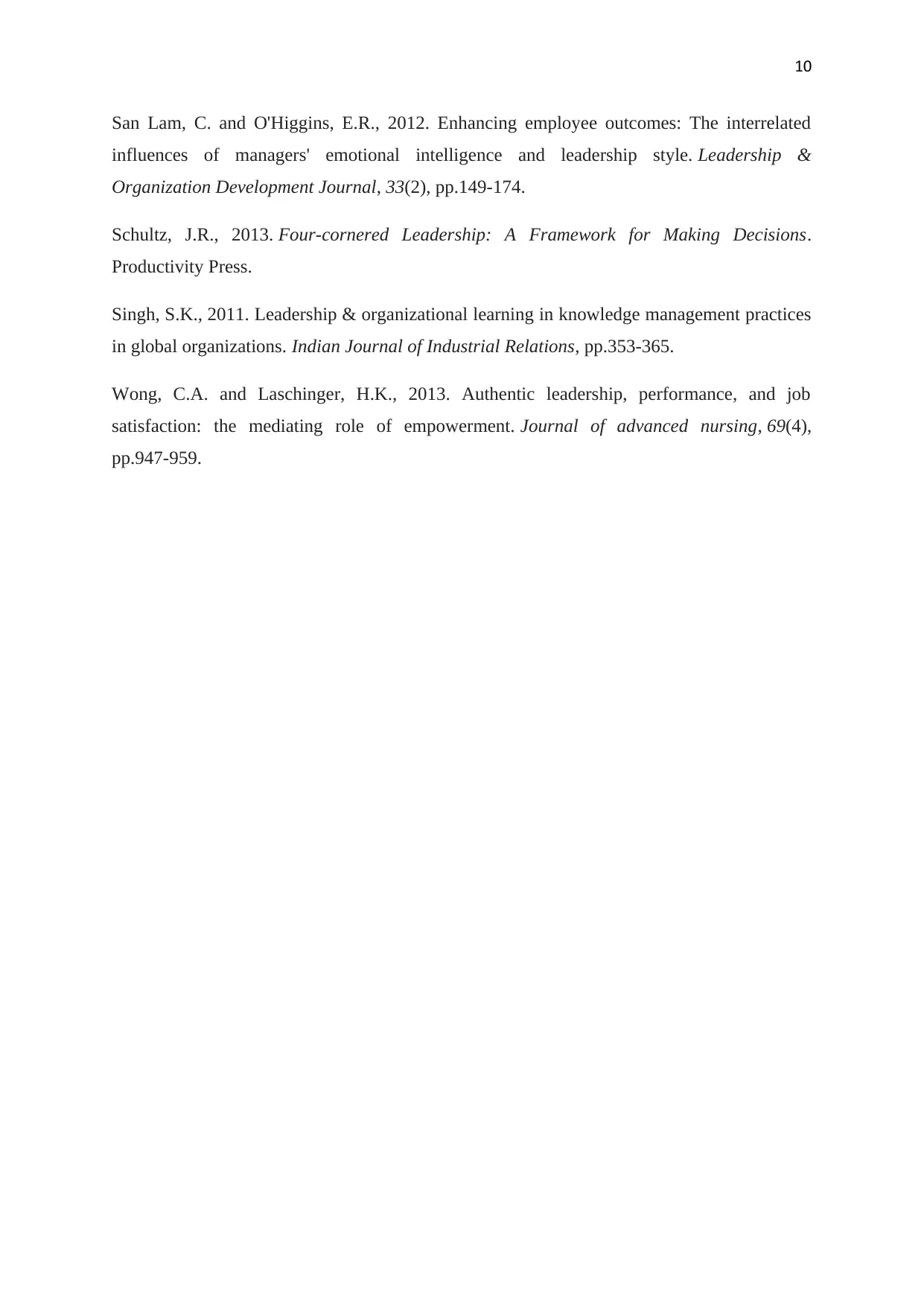
10
San Lam, C. and O'Higgins, E.R., 2012. Enhancing employee outcomes: The interrelated
influences of managers' emotional intelligence and leadership style. Leadership &
Organization Development Journal, 33(2), pp.149-174.
Schultz, J.R., 2013. Four-cornered Leadership: A Framework for Making Decisions.
Productivity Press.
Singh, S.K., 2011. Leadership & organizational learning in knowledge management practices
in global organizations. Indian Journal of Industrial Relations, pp.353-365.
Wong, C.A. and Laschinger, H.K., 2013. Authentic leadership, performance, and job
satisfaction: the mediating role of empowerment. Journal of advanced nursing, 69(4),
pp.947-959.
San Lam, C. and O'Higgins, E.R., 2012. Enhancing employee outcomes: The interrelated
influences of managers' emotional intelligence and leadership style. Leadership &
Organization Development Journal, 33(2), pp.149-174.
Schultz, J.R., 2013. Four-cornered Leadership: A Framework for Making Decisions.
Productivity Press.
Singh, S.K., 2011. Leadership & organizational learning in knowledge management practices
in global organizations. Indian Journal of Industrial Relations, pp.353-365.
Wong, C.A. and Laschinger, H.K., 2013. Authentic leadership, performance, and job
satisfaction: the mediating role of empowerment. Journal of advanced nursing, 69(4),
pp.947-959.
1 out of 11
Related Documents
Your All-in-One AI-Powered Toolkit for Academic Success.
+13062052269
info@desklib.com
Available 24*7 on WhatsApp / Email
![[object Object]](/_next/static/media/star-bottom.7253800d.svg)
Unlock your academic potential
Copyright © 2020–2025 A2Z Services. All Rights Reserved. Developed and managed by ZUCOL.




